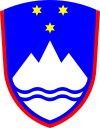National Assembly (Slovenia)
National Assembly Državni zbor | |
|---|---|
 | |
| Type | |
| Type | |
| Leadership | |
| Structure | |
| Seats | 90 |
 | |
Political groups | Government (52) Modern Centre Party (35)
Social Democrats (6)
Opposition (38) United Left (6)
New Slovenia (5)
Group of Independent Deputies (4)
Ethnic minorities (2)
Independent Deputy (2) |
| Elections | |
| Open list proportional representation with a 4% election threshold | |
Last election | 13 July 2014 |
Next election | 2018 |
| Meeting place | |
| National Assembly Building, Ljubliana | |
| Website | |
| http://www.dz-rs.si/ | |
 |
|---|
|
UN Member State |
The National Assembly (Template:Lang-sl, pronounced [dərˈʒàːwni ˈzbɔ́r rɛˈpúːblikɛ slɔˈʋèːnijɛ][1] or [-ˈzbɔ̀ːr-];[1] Slovene abbreviation [DZ] Error: {{Lang}}: text has italic markup (help)), is the general representative body of Slovenia. According to the Constitution of Slovenia and the Constitutional Court of Slovenia, it is the major part of the distinctively incompletely bicameral Slovenian Parliament, the legislative branch of the Republic of Slovenia.[2][3] It is unicameral. It has 90 members, elected for a four-year term. 88 members are elected using the party-list proportional representation system and the remaining two, using the Borda count, by the Hungarian and Italian-speaking ethnic minorities, who have an absolute veto in matters concerning their ethnic groups.
Tradition
Traditionally the representatives of the Italian and Hungarian ethnic minorities in the National Assembly are expected to support the coalition in power, regardless of its political composition, although they are not formally part of the coalition.[4]
List of Speakers of the National Assembly
- Milan Brglez (SMC): 1 August 2014 – present
- Janko Veber (SD): 27 February 2013 – 1 August 2014
- Jakob Presečnik (acting) (SLS): 28 January 2013 – 27 February 2013
- Gregor Virant (LGV/DL): 21 December 2011 – 28 January 2013
- Ljubo Germič (LDS): 2 September 2011 – 21 December 2011
- Pavel Gantar (Zares): 15 October 2008 – 2 September 2011
- France Cukjati (SDS): 22 October 2004 – 15 October 2008
- Feri Horvat (ZLSD): 12 July 2004 – 22 October 2004
- Borut Pahor (ZLSD): 10 November 2000 – 12 July 2004
- Janez Podobnik (SLS): 3 December 1996 – 10 November 2000
- Jožef Školč (LDS): 16 September 1994 – 3 December 1996
- Herman Rigelnik (LDS): 23 December 1992 – 16 September 1994
- France Bučar (SDZ): 17 May 1990 – 23 December 1992
Public servant offices
The National Assembly contains the office of deputies, the office of general secretary of the National Assembly, and the office of the speaker of the National Assembly.
Latest election
Template:Slovenian parliamentary election, 2014
Previous elections
Template:Slovenian parliamentary election, 2014
Members
- List of members of the parliament of Slovenia, 1990–1992
- List of members of the parliament of Slovenia, 1992–1996
- List of members of the parliament of Slovenia, 1996–2000
- List of members of the parliament of Slovenia, 2000–2004
- List of members of the parliament of Slovenia, 2004–2008
- List of members of the parliament of Slovenia, 2008–2011
- List of members of the parliament of Slovenia, 2011–2014
References
- ^ a b "Slovenski pravopis 2001: Državni zbor Republike Slovenije".
- ^ "U-I-295/07-8" (in Slovenian). Constitutional Court of the Republic of Slovenia. 22 October 2008. Retrieved 16 December 2010.
- ^ Lakota, Igor (2006). Sistem nepopolne dvodomnosti v slovenskem parlamentu (diplomska naloga) (PDF) (in Slovenian). Faculty of Social Sciences, University of Ljubljana. p. 62.
Opinions differ, however the majority of domestic experts agree that the National Council may be regarded as the upper house, but the bicameralism is distinctively incomplete.
{{cite book}}: Unknown parameter|trans_title=ignored (|trans-title=suggested) (help) - ^ "Manjšinska poslanca podpisala dogovor o sodelovanju z Janševo vlado". Planet Siol.net (in Slovenian). 26 January 2012.
{{cite news}}: Unknown parameter|trans_title=ignored (|trans-title=suggested) (help)
Further reading
- Toplak, Jurij. The parliamentary election in Slovenia, October 2004. Electoral Studies 25 (2006) 825-831.

